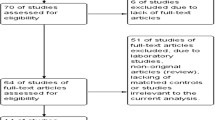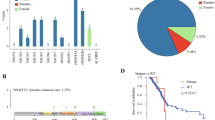Abstract
Introduction
Epigenetic modifications play an important role in multistage carcinogenesis. The role of the three functional DNA methyltransferases (DNMTs) in pancreatic carcinogenesis has not been fully understood. The main goal of this study was to examine DNMT expression in different stages of pancreatic ductal adenocarcinoma (PDAC), and evaluate their prognostic significance in PDAC.
Materials and methods
A large number of premalignant and malignant pancreatic lesions were obtained by manual microdissection. Quantitative real-time RT-PCR was used to detect DNMTs mRNA expression. Nonparametric test, log-rank test and Cox regression analysis were used to evaluate the clinical significance of DNMT expression.
Results
The mRNA expression of the three DNMTs increased with the development of pancreatic cancer from normal duct to pancreatic intraductal neoplasia and further to PDAC, and were statistically correlated with each other. Expression of the three DNMTs was statistically correlated with TNM staging and history of chronic pancreatitis. DNMT3A and DNMT3B, but not DNMT1 expression, was statistically correlated with tumour size. Patients with higher levels of DNMT1, DNMT3A and/or DNMT3B expression had an overall lower survival than those with lower levels of expression. Univariate analysis showed that high expression levels of DNMTs, alcohol consumption, tumour differentiation and TNM staging were statistically significant risk factors. Multivariate analysis showed that high level of DNMT3B expression and tumour differentiation were statistically significant independent poor prognostic factors.
Conclusions
These results suggested that pancreatic carcinogenesis involves an increased mRNA expression of three DNMTs, and they may become valuable diagnostic and prognostic markers as well as potential therapeutic targets for pancreatic cancer.
Similar content being viewed by others
References
Yokoyama Y, Nimura Y, Nagino M (2009) Advances in the treatment of pancreatic cancer: limitations of surgery and evaluation of new therapeutic strategies. Surg Today 39:466–475
Feldmann G, Beaty R, Hruban RH, Maitra A (2007) Molecular genetics of pancreatic intraepithelial neoplasia. J Hepatobiliary Pancreat Surg 14:224–232
Sipos B, Frank S, Gress T et al (2008) Pancreatic intraepithelial neoplasia revisited and updated. Pancreatology 9:45–54
Sato N, Matsubayashi H, Abe T et al (2005) Epigenetic down-regulation of CDKN1C/p57KIP2 in pancreatic ductal neoplasms identified by gene expression profiling. Clin Cancer Res 11:4681–4688
Kurdistani SK (2007) Histone modifications as markers of cancer prognosis: a cellular view. Br J Cancer 97:1–5
Esteller M (2008) Epigenetics in cancer. N Engl J Med 358:1148–1159
Robertson KD (2001) DNA methylation, methyltransferases and cancer. Oncogene 20:3139–3155
Miremadi A, Oestergaard MZ, Pharoah PD, Caldas C (2007) Cancer genetics of epigenetic genes. Hum Mol Genet 16:R28–49
Ferguson-Smith AC, Greally JM (2007) Epigenetics: perceptive enzymes. Nature 449:148–149
Okano M, Xie S, Li E (1998) DNMT2 is not required for de novo and maintenance methylation of viral DNA in embryonic stem cells. Nucleic Acids Res 26:2536–2540
el-Deiry WS, Nelkin BD, Celano P et al (1991) High expression of the DNA methyltransferase gene characterizes human neoplastic cells and progression stages of colon cancer. Proc Natl Acad Sci U S A 88:3470–3474
Patra SK, Patra A, Zhao H, Dahiya R (2002) DNA methyltransferase and demethylase in human prostate cancer. Mol Carcinog 33:163–171
Girault I, Tozlu S, Lidereau R, Bieche I (2003) Expression analysis of DNA methyltransferases 1, 3A, and 3B in sporadic breast carcinomas. Clin Cancer Res 9:4415–4422
Oh BK, Kim H, Park HJ et al (2007) DNA methyltransferase expression and DNA methylation in human hepatocellular carcinoma and their clinicopathological correlation. Int J Mol Med 20:65–73
Xiong Y, Dowdy SC, Xue A et al (2005) Opposite alterations of DNA methyltransferase gene expression in endometrioid and serous endometrial cancers. Gynecol Oncol 96:601–609
Melki JR, Warnecke P, Vincent PC, Clark SJ (1998) Increased DNA methyltransferase expression in leukaemia. Leukemia 12:311–316
Peng DF, Kanai Y, Sawada M et al (2005) Increased DNA methyltransferase 1 (DNMT1) protein expression in precancerous conditions and ductal carcinomas of the pancreas. Cancer Sci 96:403–408
Peng DF, Kanai Y, Sawada M et al (2006) DNA methylation of multiple tumor-related genes in association with overexpression of DNA methyltransferase 1 (DNMT1) during multistage carcinogenesis of the pancreas. Carcinogenesis 27:1160–1168
Wang W, Gao J, Man XH et al (2009) Significance of DNA methyltransferase-1 and histone deacetylase-1 in pancreatic cancer. Oncol Rep 21:1439–1447
Hamilton SR, Aaltonen LA (2000) Pathology and genetics of tumors of the digestive system. IARC Press, Lyon, pp 220–227
Zhou GB, Hu SP, Liu JW et al (2006) Modified manual microdissection in procuring defined cells for high-quality RNA acquisition. Chinese J Biochem Mol Biol 22:252–257
Hruban RH, Takaori K, Klimstra DS et al (2004) An illustrated consensus on the classification of pancreatic intraepithelial neoplasia and intraductal papillary mucinous neoplasms. Am J Surg Pathol 28:977–987
Maitra A, Adsay NV, Argani P et al (2003) Multicomponent analysis of the pancreatic adenocarcinoma progression model using a pancreatic intraepithelial neoplasia tissue microarray. Mod Pathol 16:902–912
Hustinx SR, Leoni LM, Yeo CJ et al (2005) Concordant loss of MTAP and p16/CDKN2A expression in pancreatic intraepithelial neoplasia: evidence of homozygous deletion in a noninvasive precursor lesion. Mod Pathol 18:959–963
Walch A, Specht K, Smida J et al (2001) Tissue microdissection techniques in quantitative genome and gene expression analyses. Histochem Cell Biol 115:269–276
Author information
Authors and Affiliations
Corresponding author
Additional information
These authors contributed equally to this work.
Rights and permissions
About this article
Cite this article
Zhang, JJ., Zhu, Y., Zhu, Y. et al. Association of increased DNA methyltransferase expression with carcinogenesis and poor prognosis in pancreatic ductal adenocarcinoma. Clin Transl Oncol 14, 116–124 (2012). https://doi.org/10.1007/s12094-012-0770-x
Received:
Accepted:
Published:
Issue Date:
DOI: https://doi.org/10.1007/s12094-012-0770-x




